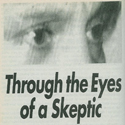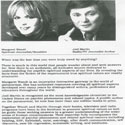

You will need to have Adobe Acrobat Reader installed to view the UFO articles. Download it from here.
Articles
Dreams and disaster happening at the same time.

Dr. Antonio de Nicolas' brother has just been elected the 30th Superior General of the Society of Jesus! History is made! Click here.
New superior urges Jesuits to strengthen service to poor. Click Here
Province Express - Father Adolfo Nicol�s. Click Here
- Is a New Eugenics Afoot? by Garland E. Allen
- The 1929 Arab Terror Attack: When Hebron Became Occupied Territory by Sammy Benoit
- "Saturn enters Libra"
- 'I am sorry,' Cardinal Mahony says amid new priest abuse details
- 04/07/08 We are all African
- 04/23/08 Moody's Blues
- 05/06/08 Lunacy and Freedom
- 05/10/08 It's not easy being Green, or even truthful it would seem
- 05/21/08 Shareholder Value
- 05/26/08 Senator Clinton, Fear, and Assassination
- 06/02/08 The Lesson Derived From Derivatives
- 06/12/08 The Price of Ice Cream
- 06/23/08 The Market
- 06/25/08 Getting Hit By A Bus
- 07/11/08 Being Right
- 07/18/08 Einstein
- 07/18/08 Karma
- 07/21/08 Ecology, Security and Economics
- 08/01/08 Who We Have Been Waiting For
- 08/11/08 From The Head To The Heart
- 08/20/08 Incarceration
- 08/28/08 Frick and Frack
- 09/10/08 Worrying
- 09/17/08 Taxpayer Bailout
- 10/16/08 Deleveraging
- 11/23/08 Too Big to Survive
- 11/24/08 Getting Hit By a Bus
- 2014: Sag New Moon --Change that perspective-NOW!
- 2024 Capricorn New Moon: Let's Get Your Cap On!
- 2nd Aquarius New Moon: 2015
- ACE OF CUPS
- ACE OF PENTACLES
- ACE-OF-SWORDS
- ACE-OF-WANDS
- After Lehman
- Amazing New Video -- The 2012 Enigma! by David Wilcock
- An Extraordinary Astrological Recapitulation by Brian McNaughton
- And now it is the Second Cancer New Moon!
- Aqaurius New Moon 2011--The New Quilting BEE!
- Aquarius New Moon 2010! It is a strange trip
- Aquarius New Moon 2012!
- Aquarius New Moon 2014 - You LikeMind me.
- Aquarius New Moon 2015 - The Zero One
- Aquarius New Moon 2016: Get Your Tribe On
- Aquarius New Moon 2017: Out of the chaos we find our Peeps.
- aquarius New Moon 2017: Out of the chaos we find our Peeps.
- Aquarius New Moon 2017: Out of The Chaos We Find our Peeps!!
- Aquarius New Moon 2018: Friends & Communities
- Aquarius New Moon 2019: No Time or Place for Emotions
- Aquarius New Moon 2020: Expect the Unexpected
- Aquarius New Moon 2021 Your Place in the Community
- Aquarius New Moon 2022: Loneliness or Circles? Your choice!
- Aquarius New Moon 2023: Wear Your Weird
- Aquarius New Moon 2024: Pluto is Getting Our Attention
- Aquarius New Moon 2025
- Aquarius New Moon--Unique Solutions if you are willing
- ARCHANGEL MICAHEL: SOUL'S JOURNEY
- ARCHANGEL MICHAEL: FAMILY AND FRIENDS
- Archangel Michael: INTENTIONS
- ARCHANGEL URIEL: STRESS
- Archangels: Stress
- Aries New Moon #1 March 2023
- Aries New Moon #2 - April 19th 2023 PDT
- Aries New Moon - It will be a great Treasure Map time!
- Aries New Moon 2009---IT’S A BIG ONE!
- Aries New Moon 2010--Let's get this party started!
- Aries New Moon 2012: You rule!
- Aries New Moon 2014 Get out of the way! Your Life is Coming
- Aries New Moon 2016: Light this rocket!
- Aries New Moon 2017
- Aries New Moon 2018: What Are Your Instincts Telling You?
- Aries New Moon 2019: Patience. Yes. That Word.
- Aries New Moon 2020: Survival
- Aries New Moon 2021: Heart Driven Changes
- Aries New Moon 2022: Finding Self Now!
- Aries New Moon 2024 Total Solar Eclipse - Wow.
- Aries New Moon 2025: A New Beginning for All
- Aries New Moon! (2008) by Tracy Cook
- Aries New Moon, 2011- Yes it is a big one!
- Article by Jock Brocas
- Back on Uncle Sam's Plantation
- Being Frugal and Benefiting
- Biomass-Eating Military Robot Is a Vegetarian, Company Says
- Bob Dylan: Like a Complete Unknown by Ron Radosh
- Books mentioned in Brian Hurst's broadcasts
- Britain Hired Astrologer to Fight Hitler
- Buddhism and the End of Economic Growth by John Stanley & David Loy
- Cancer Eclipse & New Moon 2019: Your Emotions Will Guide You
- Cancer New Moon & The Grand Cross
- Cancer New Moon --The Great Healing by Tracy Cook
- Cancer New Moon 2010---Your feelings have answers
- Cancer New Moon 2012 - "It's the flow, Baby!"
- Cancer New Moon 2014: REFRESH!
- Cancer New Moon 2016: Let It Flow
- Cancer New Moon 2017: Are your emotions flowing? Good.
- Cancer New Moon 2023: Ride the Rapids
- Cancer New Moon 2024: Emotions, Feelings and Needs- Oh, My!
- Cancer New Moon Solar Eclipse June 20, 2020
- Cancer New Moon--The first of two (2009)
- Cancer New Moon-Ready, Set, Emote! July, 14th 2007 by Tracy Cook
- Cancer New Moon: 2013
- Cancer New Moon: 2022 - Emotions Guide Us To Our Heart
- Cancer New Moon: Don't make me go find your roots...you do it!
- Cancer New Moon: Feelings. Emotions. Passion. 2021
- Cancer Solar Eclipse 2018
- Capricorn 2010 NEW MOON--Taking Care of Business!
- Capricorn 2011-Aim your ambition-NOW
- Capricorn New Moon - Get Serious!
- Capricorn New Moon 2011 -Be the authority and move up!
- Capricorn New Moon 2013: Pragmatic and no excuses
- Capricorn New Moon 2014
- Capricorn NEW MOON 2016 ...Get Real!
- Capricorn New Moon 2018
- Capricorn New Moon 2019 - Pragmatism Pragmatism Pragmatism
- Capricorn New Moon 2019: Focused and Disciplined
- Capricorn New Moon 2019: Focused and Disciplined
- Capricorn New Moon 2021. Climb Like a Goat
- Capricorn New Moon 2022: Climb Heights
- Capricorn New Moon 2025 Ambition for You
- Capricorn New Moon Dec 2022: CEO of Values
- Capricorn New Moon: Slow and sensible is a-okay.
- Children Skipping Childhood
- Clean your Slate Capricorn New Moon! by Tracy Cook
- Compliments Do You Get Enough Of Them?
- David Kaiser from MIT, not David Kaiser from the Naval War College
- Detach From Rescuing
- Did Yale prostitute itself for oil money? by Ethel C. Fenig
- Do I Remember Differently Than Another Does?
- Do you feel good about where you live? by Jill Saint James
- Dreaming on Pisces New Moon by Tracy Cook
- ECSTASY
- Energetic Health Food By Eva Sanchez,N.D.
- Face The Music
- Fox Blowviator Bill O'Reilly wants you to hate him
- GEMINI NEW MOON 2011 –“Can someone turn on the air, please?”
- Gemini Eclipse New Moon 2021: Fact versus Fiction and Pivot !
- Gemini New Moon (2012)- Second time's the charm
- Gemini New Moon 2009---The Fast and Furious Talker
- Gemini New Moon 2010: A Tornado among us!
- Gemini New Moon 2013
- Gemini New Moon 2014: The power of light feet
- Gemini New Moon 2014: The power of light feet
- Gemini New Moon 2018 - Thoughts!
- Gemini New Moon 2019: Mix it up & Adapt
- Gemini New Moon 2020: Reboot Your Inner Computer
- Gemini New Moon 2022: Process the Information
- Gemini New Moon 2023: Fuzzy Data But Still Informs
- Gemini New Moon 2024: Cha-Cha-Cha-ing
- Gemini New Moon by Tracy Cook
- Gemini New Moon-- Reach out! Mix it Up!
- Gemini New Moon--the first round- 2012
- Gemini New Moon. Mental Exercises 2015
- Gemini New Moon. Mental Exercises 2015
- Gemini New Moon: Question and Shift
- Gemini- New Moon 2008-- Ready to Connect! by Tracy Cook
- Get out of the way---LEO NEW MOON is HERE!
- Get your Viking on--Aries New Moon 2013
- Getting the Scoop by Janet Donovan
- Glossary of Number Values
- God + Faith by Margaret Wendt
- God Heard The Need
- Headaches are Telling You Something by Eva Sanchez, N.D.
- Heart Ethics by Way of Introduction by Dr. Antonio T. de Nicolas, PHD
- Hi Ho Silver!!
- History Unfolding by David Kaiser
- How American corporate philanthropies launched a national campaign of ethnic cleansing in the United States, helped found and fund the Nazi eugenics of Hitler and Mengele — and then created the modern movement of "human genetics." by Edwin Black
- How to sit with a medium
- I Forgot To Accept The Things I Can Not Change
- I Want Your Help, I’m An Atheist
- In a generation or two, the US will ask itself: "Who lost Europe?"
- In fallout from crisis, rethinking risk and human judgment by Lynnley Browning
- Incredible information and facts about the paranormal and publishing
- Is A Shift Needed in Parenting Values?
- Is Your Community Antisocial?
- It is all a balancing act, Baby! Libra new moon 2008
- Jess Stearn
- JFK Junior - John Jr. by Sloan Bella
- Jon Bennett Ramsey by Sloan Bella
- Keeping a Tally Sheet
- Kurt Cobain - Celebrity Channel by Sloan Bella
- Learn about Boundaries
- Lemon for Lymph By Eva Sanchez N.D.
- LEO 2008 New Moon--Sunny side of the street by Tracy Cook
- Leo New Moon - Round two & Solar Eclipse 2017
- Leo New Moon - The First One! 2017
- Leo New Moon - The First One! 2017
- Leo New Moon - To be bold or not to be bold? That is the question
- Leo New Moon 2011--Your passion tells you so
- Leo New Moon 2012--The Heart Wants To Thrive
- Leo New Moon 2013: Be Big. Be Very Big
- Leo New Moon 2015: Learn from the Lion!
- LEO NEW MOON 2016: Dare to find Joy & Strength
- Leo New Moon 2019: Be Special, dang it!
- Leo New Moon 2020: Put on Your Sloppy Cape
- Leo New Moon 2023 - 29 Days of Brave
- Leo New Moon 2024: Love, Strength and Courage
- Leo New Moon Eclipse 2018
- Leo New Moon: 2021 - Find Your Authentic Heart
- leo New Moon: 2021 - Find Your Authentic Heart
- Leo New Moon: 2022 - Be YOU.
- Leo's in the House..Roar! Sort of.. by Tracy Cook
- Libra New Moon (2007) by Tracy Cook
- Libra New Moon -How do you relate? Does it serve you?
- Libra New Moon 2009--The business of relating
- Libra New Moon 2012-
- Libra New Moon 2013 -- Balance That!
- Libra New Moon 2014: Let's really get our Libra on this time
- Libra New Moon 2015: Get your relationships straightened out
- Libra New Moon 2016: The Power of Negotiation
- Libra New Moon 2017: Not as light as you think
- Libra New Moon 2018: Power & Negotiations & Self Worth. Repeat.
- Libra New Moon 2019: Your Identity, My Identity & An Oxygen Mask
- Libra New Moon 2020: Bumpy. Power. Kindness. Repeat.
- Libra New Moon 2021: Where's your balance?
- Libra New Moon 2022 : How are your relating skills?
- Libra New Moon Eclipse 2023
- Libra New Moon Eclipse 2024: What's That Zagging?
- Look In My Eyes
- Love in the Land of Loneliness by Joseph Dispenza
- Marilyn Monroe - June 2004 - Celebrity Channel by Sloan Bella
- MAY GOD BLESS THIS AIRLINE CAPTAIN
- Me Controlling
- Meditation: The Making of Images By Antonio T. de Nicolas, PhD
- Mindy Sommers
- Mirror Mirror On The Wall
- My Global Warming Epiphany by Randall Hoven
- Narcissistic Behavior Is Increasing
- Neediness
- Nevins Rules by Julie Salamon
- New Moon in Aquarius 2013 Pull out your lightening rod-hits are coming
- New Moon in Virgo--Now you can fix your life
- New Moon Leo 2010--Wish upon a star--"Hey, that's me!"
- No One Mention The War!
- Pass The Buck
- Patience is a Virtue
- Pisces 2021 New Moon - All We Need is Love
- Pisces New Moon 2010--The LEAP of FAITH
- Pisces New Moon 2012: What is Dissolving?
- Pisces New Moon 2013 -Get in the flow
- Pisces New Moon 2014: Go for the Flow
- Pisces New Moon 2015
- Pisces New Moon 2016: Karma and Elevation
- Pisces New Moon 2017 -- The Big Release and Melt
- Pisces New Moon 2018: Intuition Speaks Are You Hearing It?
- Pisces New Moon 2019: Dazed and Confused --Thank You For It
- Pisces New Moon 2020: Time to Get Quiet
- Pisces New Moon 2022: Finding the Inner World
- Pisces New Moon 2023: Beep!
- Pisces New Moon 2024: Connecting to Bigger
- Pisces New Moon 2025: Unplug and Replenish
- Pisces New Moon---Mystics Apply
- Pisces New Moon--Dive or wash up on shore, it is your choice!
- Private Space Is Healing
- Psychic portraits of the Bangs Sisters
- Psychics, Mediums, and Rock N Roll
- Raymond Moody
- Re-wounding
- Re: Mars turns retrograde as Jupiter conjuncts Neptune on the Winter Solstice
- Re: Planetary Forecasting Methods for Traders
- Re: Saturn turns retrograde; Solar Eclipse; Mercury turns direct; Jupiter enters Pisces
- RESPOND TO RESPONSIBILTY-CAPRICORN NEW MOON 2008
- Responsibility Came From Being Told No
- Robert Monroe
- Sag New Moon 2010-- Ready, Aim---Change!
- Sag New Moon 2012 - A time to get real
- Sag New Moon 2021 Total Eclipse
- Sag New Moon 2023: Bits of Joy is still Joy
- Sag New Moon Total Eclipse 2020: The Truth is in The Mirror
- Sag New Moon---All Vision without the Hype!
- Sagittarius New Moon 2009--Ready, Aim, Adjust...Fire, Adjust, Aim, Ready..
- Sagittarius New Moon 2013 - Forward Ho!
- Sagittarius New Moon 2015: The Adventure!
- Sagittarius New Moon 2016: Get Wise Get Inspired
- Sagittarius New Moon 2017 - On Top of The Galactic Center
- Sagittarius New Moon 2018 - Get Inspired. Now!
- Sagittarius New Moon 2019: Hot & Cold Wisdom
- Sagittarius New Moon 2024: Finding The Way
- Sagittarius New Moon--Mother Knows Best
- Scorpio New Moon (2017) : Act Like a Plumber!!
- Scorpio New MOON 2009-Resources and Community--Where do I fit?
- Scorpio New Moon 2010-Jump in the water!
- Scorpio New moon 2012: Suit up and Commit
- Scorpio New Moon 2015
- Scorpio New Moon 2016: Release the death grip
- Scorpio New Moon 2018 - Rejuvenate!
- Scorpio New Moon 2019 - Shocked to Vulnerability
- Scorpio New Moon 2020: Dig Deep & Get Rid of Debris
- Scorpio New Moon 2023: Depth & Release
- Scorpio New Moon 2024: Tapping Power & Getting Unstuck
- Scorpio NEW MOON by Tracy Cook
- Scorpio New Moon Solar Eclipse SHED! SHED!SHED!
- Scorpio New Moon(2011)--DNA, Survival and ditching Garbage
- Scorpio New Moon: Get Your Plumbers Butt On!
- scorpio New Moon: Get your Plumbers Butt on!
- Scorpio New Moon: Solar Eclipse 2014
- scorpio New Moon: Solar Eclipse 2015
- Scorpio Solar Eclipse New Moon 2022: Release. Got it?
- Second Cancer New Moon 2020
- Sharia rejects all fundamental premises
- Speaking From Experience
- Speech by Lou Pritchett
- SURE RELATIONSHIPS BITE--BUT WE'RE ALL HUNGRY. Libra New Moon 2010
- Taurus New Moon 2008!
- Taurus New Moon 2010-----And so we begin.......
- Taurus New Moon 2011--Build upon it!
- TAURUS NEW MOON 2012 --What do you value?
- Taurus New Moon 2017: Practicality for a Personal Revolution
- Taurus New Moon 2018: Making Changes Bit by Bit
- Taurus New Moon 2019: Feel The Changes
- Taurus New Moon 2020: The rest of the year and being practical
- Taurus New Moon 2021. Slow down and find your values.
- Taurus New Moon 2022: Our Resources, our Love our Values!
- Taurus New Moon 2024: The Power of Slowing Down
- Taurus New Moon Eclipse: Yes you can make the changes!
- Taurus New Moon. Getting Practical ..Seriously, for real
- Taurus New Moon: May 19 The Glory of Practicality!
- Taurus New Moon: 2025 - Finding Stability In Extraordinary Times
- Taurus New Moon: Take the short route between A&B
- Taurus to the RESCUE!
- TaurusNewMoon 2014--Building Good bit by bit
- The Alinskyite's Big, Fat Governance Failure by Kyle-Anne Shiver
- The collapse of the U.S. Dollar and Federal Reserve? by Ted Phillips
- The coming collapse of the U.S. Dollar and Federal Reserve?
- The Consoling Angel by Antonio de Nicolas
- THE EMPEROR
- THE EMPRESS
- THE FOOL- MAJOR ARCANA
- The Ghosts on Moaning Mountain
- THE HEIROPHANT
- THE HIGH PRIESTESS
- The Horrifying American Roots of Nazi Eugenics by Edwin Black
- THE MAGICIAN- MAJOR ARCANA
- The Most Important Astrological Chart for Your Financial Security
- The Nightmare of Rationing in Oregon by Jeff Emanuel
- The Price of Ice Cream by Bill Sharon
- The Promise of the Past by Betty J. Kovács, Ph.D.
- The Reincarnation of Edgar Cayce and His Soul Group? - You Decide.
- The Sea has changed---SCORPIO NEW MOON 2008
- The Shadow and Karma
- The Spiritual Candle
- The Thieves of Happiness
- There she blows!!! SAG NEW MOON is HERE! by Tracy Cook
- Thomas Edison's Paranormal Personality by Margaret Wendt
- Thomas J. Curry must Leave Santa Barbara
- Tick Tock Virgo New Moon Strikes the Clock....2008
- Time To Connect With Like Minds
- Too Much Of A Good Thing....Is It Really Wonderful?
- Treasure Mapping by Tracy Cook
- Verbal Abuse Hurts
- Virgo 2018 New Moon - A Hero's Journey
- Virgo 2019 New Moon - A Car Full of Nerves
- Virgo New Moon - Your daily life is YOU. How is it going?
- VIRGO NEW MOON --GET YOUR MICRO ON!
- Virgo New Moon 2011- Help & Work serve you!
- Virgo New Moon 2012: Sweating the Small Stuff
- Virgo New Moon 2013: A Big Opportunity
- Virgo New Moon 2016 - What's that stuff in your schedule?
- Virgo New Moon 2017: Skills Needed! Please Apply
- Virgo New Moon 2021: Daily efforts build your life
- Virgo New Moon 2022: Don't be a burnt out Roomba
- Virgo New Moon 2023: Keep Your Head Down & Do The Work
- Virgo New Moon by Tracy Cook
- Virgo New Moon--Details Rule
- Virgo New Moon: 2020 - Every choice is yours
- Virgo New Moon: 2024 - Control Your Future By Your Schedule
- Vowels by Jill Saint James
- What Does Cutting Back On Expenses Mean To You?
- What Is A Distraction?
- What To Do This Taurus New Moon by Tracy Cook
- Where have all of the leaders gone? by Lee Iacocca
- Who Has Time To Read?
- You Feel Their Pain
- You had me at Hello, Aquarius New Moon by Tracy Cook
- You Lose Out When You Judge a Book by Its Cover
- You Make The Choice I Don't Care
- ‘Transce-end’ the trance – Bring out your dead!
- Uri Geller
- Margaret and Joel
- Houdini
Letters Sent to Us from the Public
- The 1929 Arab Terror Attack: When Hebron Became Occupied Territory by Sammy Benoit
- Biomass-Eating Military Robot Is a Vegetarian, Company Says
- Bob Dylan: Like a Complete Unknown by Ron Radosh
- Buddhism and the End of Economic Growth by John Stanley & David Loy
- David Kaiser from MIT, not David Kaiser from the Naval War College
- Did Yale prostitute itself for oil money? by Ethel C. Fenig
- History Unfolding by David Kaiser
- My Global Warming Epiphany by Randall Hoven
- The Alinskyite's Big, Fat Governance Failure by Kyle-Anne Shiver
- The collapse of the U.S. Dollar and Federal Reserve? by Ted Phillips
- The Nightmare of Rationing in Oregon by Jeff Emanuel
- Where have all of the leaders gone? by Lee Iacocca
Articles by Joel Martin
- Through the Eyes of a Skeptic
- Question and Answers
- Who Believes in the Paranormal?
- Nancy Reagan
- Ghost Ship
- I'm gonna get you 'suckers'
- Margaret Wendt and Joel Martin's New Book
Articles by Margaret Wendt
Paper Media: click thumb (where applicable) for full size image/.pdf files

Margaret's Magazine 1
Margaret's Magazine 2
Margaret's Magazine 3
Margaret's Magazine 4
Margaret's Magazine 5

News Anchor's
UFO experience
My Favorite Martian
Article by M. Wendt
Robert Urich
Spirit Magazine
The Healers Magazine
Entertainment Tonight
Magazine for Cleveland
- News Anchor's UFO Experience by Margaret Wendt
- My Favorite Martian by Margaret Wendt
- Looking for Love by Margaret Wendt
- God + Faith by Margaret Wendt
- Thoms Edison's Paranormal Personality by Margaret Wendt
- Margaret and Joel
- Who was Hayim Solomon?
- Nevins Rules by Julie Salamon
- Psychic portraits of the Bangs Sisters
- Psychics, Mediums, and Rock N Roll
- The Ghosts on Moaning Mountain
- The Spiritual Candle
- Thomas Edison's Paranormal Personality by Margaret Wendt
- Margaret Wendt and Joel Martin's New Book
Is a New Eugenics Afoot? by Garland E. Allen
The April 1998 issue of Life magazine ran a cover story, complete with a double-helix spanning the length of the page, boldly titled "Were You Born That Way?" The subtitle left no doubt about the answer: "Personality, temperament, even life choices. New studies show it's mostly in your genes."
Life was not alone in promoting such claims. In the past 15 years, Atlantic Monthly, New Republic, U.S. News and World Report, Time, and Newsweek, to mention only a few, have all carried cover stories emphasizing the contribution of genes to our social behavior. Coat-tailing on major advances in genetic biotechnology, these articles portray genetics as the new "magic bullet" of biomedical science that will solve many of our recurrent social problems. The implication is that these problems are largely a result of the defective biology of individuals or even racial or ethnic groups. If aggressive or violent behavior is in the genes, so the argument goes, then the solution lies in biomedical intervention--gene therapy in the distant future and pharmacotherapy (replacing the products of defective genes with drug substitutes) in the immediate future.
By promoting such claims, are we heading toward a new version of eugenics? Are we getting carried away with the false promise of a technological fix for problems that really lie in the structure of our society? My answer to these questions is "yes," but with some important qualifications that derive from the different historical and social contexts of the early 1900s and the present. Examining the development of eugenics in the early 20th century, especially in the United States, can be instructive for evaluating how genetics can be used and misused in biomedicine today. Among other things, that history helps to clarify the meaning of the term eugenics in both its older and more modern usage.
The term eugenics was coined in 1883 by the Victorian polymath Francis Galton, geographer, statistician, and first cousin of Charles Darwin. It meant to him "truly- or well-born," and referred to a plan to encourage the "best people" in society to have more children (positive eugenics) and to discourage or prevent the "worst elements" of society from having many, if any, children (negative eugenics). Eugenics became solidified into a movement in various countries throughout the world in the first three decades of the 20th century, but nowhere more solidly than in the United States and, after World War I, in Germany. In most cases, although not all (France and some Latin American countries were notable exceptions), eugenicists' views were based on the theory of heredity first published by Gregor Mendel in 1866, but not fully appreciated until after 1900.
Given the wide variety of theories of heredity in vogue by the end of the 19th century, biologists were excited to find a single theory of inheritance that seemed to apply across the entire living world from peas to human beings. The most attractive feature of Mendelian genetics was that it was particulate, experimental, and quantitative. Early Mendelian geneticists adhered to the unit-character hypothesis, that is, they believed that each trait is governed by a single gene (and its alleles). By the 1920s, the majority of laboratory geneticists recognized that most traits are produced by the interaction of several sets of genes. But this nuance was lost on most eugenicists, who continued to believe in "strong heredity," that is, a direct relationship between the presence of an hereditary determinant (now called the genotype) and the production of a relatively invariant adult trait (the phenotype).
By 1910, several human traits--such as red-green color-blindness, the A-B-O blood groups, hemophilia, and certain varieties of eye color--were found to be inherited in a basically Mendelian fashion. But eugenicists were more interested in the inheritance of social behaviors, intelligence, and personality. Proponents of eugenics carried out elaborate research programs to determine the type of inheritance these traits exhibited (dominant, recessive, incompletely dominant, sex-linked, etc.).
Eugenicists attempted to analyze the inheritance of traits by using correlation studies between relatives and family pedigree charts. The basic assumption was that if a trait recurred in families over several generations, it must be genetic. For example, the American eugenicist Charles B. Davenport, director of the Station for Experimental Evolution and the Eugenics Record Office at Cold Spring Harbor, Long Island, New York, constructed elaborate pedigrees for Huntington's chorea, albinism, epilepsy, feeblemindedness, and thalassophilia or "love of the sea" (which he found to be a Mendelian sex-linked recessive, especially prominent in the families of naval officers). Harry H. Laughlin, superintendent of the Eugenics Record Office, studied the inheritance of criminality, feeblemindedness, and many other deleterious traits in different ethnic and racial groups. He concluded that eastern Europeans, Mediterraneans, and Russian Jews, among others, harbored a large number of defective genes in their populations. Such studies, sprinkled with anecdotes, formed the backbone of eugenic "science."
American eugenicists also strove to disseminate the results of eugenic research to the public and to lawmakers. They supported the idea of positive eugenics, but focused most of their energies on negative eugenics. Eugenicists wrote hundreds of articles for popular magazines, published dozens of books for the general (and some for the scientific) reader, prepared exhibits for schools and state fairs, made films, and wrote sermons and novels.
Eugenicists also worked assiduously to establish eugenics-based legislation in the United States. Laughlin was appointed "Expert Eugenics Witness" to the House Committee on Immigration and Naturalization in 1921. His prison and hospital data were critical in convincing the Committee that America's germ plasm was being weakened by mixing with the lower quality genes coming from southern and eastern Europe, the Balkans, and Russia. This led to passage of the Johnson-Reed Act in 1924, which restricted immigration from these regions. Laughlin and others also lobbied at the state level for the passage of eugenic sterilization laws, which would allow individuals in state institutions to be forcibly sterilized if they were judged to be genetically defective. Over 35 states passed, and used, such laws. By the 1960s, when most of these laws were beginning to be repealed, more than 60,000 people had been sterilized for eugenic purposes. In Germany, the National Socialists used Laughlin's model as one of the bases of their sweeping sterilization law of 1933, which ultimately led to the sterilization of over 400,000 people.
It would be wrong to think that eugenics had no critics. Numerous objections to eugenic claims were raised by scientists and laypersons. However, most scientific criticism came only after the mid-1920s, stimulated by the crude comments by some eugenicists and restrictionists during the immigration debates. Herbert Spencer Jennings at the Johns Hopkins University, strongly criticized Laughlin's means of gathering his prison and hospital survey data. Thomas Hunt Morgan, at Columbia University, criticized the failure of eugenicists to define traits like feeblemindedness or criminality. He also pointed out that where traits were clearly influenced by social conditions, it was impossible to make any claims for a specific genetic influence, even if it were there. The anthropologist Franz Boas, also at Columbia, claimed that eugenics was racism disguised as science, and journalist Walter Lippmann exposed the fallacies of I.Q. tests, used to argue for a genetic basis for intelligence.
None of these criticisms seemed to deter the eugenicists, who continued to flourish through the mid-1930s in the United States, but funding sources began to move their philanthropic dollars elsewhere; the Carnegie Institution of Washington closed the Eugenics Record Office in 1939. At the same time, eugenics took on a new life in Germany under the Nazis after 1933.
What was the context in which this eugenics movement developed? How and why did it become so popular, and how does that context compare with our own? And finally, what are the similarities and differences between eugenics in the early 1900s and the situation today?
The period from 1880 to 1920 was one of rapid social, economic, and political change in many Western countries, particularly the United States. It was the period of rapid industrialization, urbanization, the ascendancy of agribusiness over the family farm, and the growth of a militant labor movement. Urbanization increased the visibility of alcoholism, prostitution, and degeneracy. The period was punctuated by a series of major depressions roughly every decade from 1873 onward, and by a tendency toward monopolization. Industrial leaders could not predict and plan effectively because of the randomness of the cycles.
One major response to these problems was Progressivism, a movement that began in the industrial sector. Its ideas were used to address the root causes of economic and social problems in all aspects of society. Eugenics fit perfectly with Progressive ideology. Eugenicists were scientifically trained experts who sought to apply rational principles to solving the problems of antisocial and problematic behavior by seeking out the cause, in this case poor heredity. The best schooling and social training--like the best soil--was of no avail if hereditary constitution was defective. Eugenicists were to be the "managers" of the human germ plasm, in the progressive spirit, and would take control of human evolution. Eugenicists often portrayed themselves as efficiency experts, helping to save society millions of dollars by sterilizing defectives so that the state would not have to care for their offspring. In both the United States and Germany, such economic arguments were central to eugenic propaganda. In Germany, where economic conditions in the depression era of the 1930s were considerably worse than elsewhere, saving the state money became one of the dominant themes in eugenic arguments for euthanasia, when even supporting those who were sterilized became too expensive.
What does this historical account tell us about our genetic and reproductive decisions today, at a time when hopes are high for the application of new genetic technology to both medical and social problems? Is a new eugenics afoot?
The early 20th-century eugenics movement was a product of a particular economic, social, and scientific context: a highly transitional period in American economic and industrial expansion, the advent of a new genetic paradigm, and the ideology of rational management by scientifically trained experts. As historian Sheila Weiss has emphasized, there was enough logic to the eugenic argument--saving the hard-pressed taxpayer the burden of supporting masses of supposedly defective people--to give it popular appeal. For a segment of the biological community, it provided career opportunities that could be justified as the application of their science directly to the solution of social problems. For the wealthy benefactors that supported eugenics, such as the Carnegie, Rockefeller, Harriman, and Kellogg philanthropies, eugenics provided a means of social control in a period of unprecedented upheaval and violence. It was these same economic elites and their business interests who introduced scientific management and organizational control into the industrial sector.
I would argue that we are poised at the threshold of a similar period in our own history and are adopting a similar mind frame as our predecessors. A "bottom line" mentality is rapidly becoming our guidepost. It is unlikely that we will see a return to blatant demands for sterilization, but the requirement of antifertilization medication for continued welfare benefits in the U.S., and bitter anti-immigration sentiment in southwestern U.S. and Europe are haunting reminders that we are not immune to the prejudices of our predecessors. In 1994 (The Bell Curve) we saw the resurrection of claims that there are genetic differences in intelligence between races, leading to different socio-economic status. Claims about the genetic basis for criminality, manic depression, risk-taking, alcoholism, homosexuality, and a host of other behaviors have also been rampant in scientific and especially popular literature. Much of the evidence for such claims is as controversial today as in the past.
We seem to be increasingly unwilling to accept what we view as imperfection in ourselves and others. As health care costs skyrocket, we are coming to accept a bottom-line, cost-benefit analysis of human life. This mind-set has serious implications for reproductive decisions. If a health maintenance organization (HMO) requires in utero screening, and refuses to cover the birth or care of a purportedly "defective" child, how close is this to eugenics? If gene or drug therapy is substituted for improving our workplace or school environments, our diets and our exercise practices, how close is this to eugenics? Significant social changes are expensive, however. If eugenics means making reproductive decisions primarily on the basis of social cost, then we are well on that road.
ATTENTION!
It has been brought to our attention that Margaret is being portrayed as a psychic on $1.99 sites. These sites are doing so without Margaret's permission. Margaret has not claimed she is a psychic. - MW















